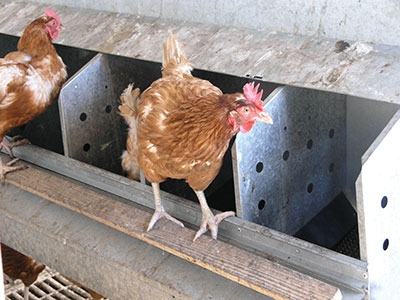
The Beaker: November 2013
By Karen Dallimore
Features Health Layers Poultry Research Protection ResearchPrevention of Keel Bone Breakage in Laying Hens
 Ensuring that one welfare problem will not replace another is the focus of Mike Petrik’s research.
Ensuring that one welfare problem will not replace another is the focus of Mike Petrik’s research. Mike Petrik has been a laying hen veterinarian for 15 years and has just completed his master of science in animal welfare at the University of Guelph under the supervision of animal behaviour and welfare specialist Tina Widowski, professor in the department of Animal and Poultry Science, and Michele Geurin, DVM, an associate professor specializing in poultry management at the Ontario Veterinary College.
Petrik’s research will set a baseline for welfare parameters in floor and conventional cage barns for laying hens, comparing the incidence of keel bone fracture rates and feather condition between the two housing systems.
Although it is scientifically established that hens in conventional cages have weaker bones than cage-free hens due to lack of exercise (one of the welfare concerns of cages), the high-producing hen of today typically depletes the calcium in her bones, which leads to osteoporosis and fragile bones. In non-cage systems there is an increased risk for injury – even though hens’ bones are stronger. The keel bone, which is the pointed bone where the breast muscles attach (similar to the sternum in humans), seems to be one of the most affected. Fractures and deformities of keel bones have become one of the top welfare issues of the laying hen.
While studies have been done in Europe, Petrik says this is the first study of its kind in North America: “Since our production methods, housing densities, nutrition and egg size targets are quite different, our rates may be quite different.”
Petrik collected data from 10 cage-housed systems and 10 floor barns (“free-run”) at 20 farms across Ontario, using all brown birds for consistency. Fifty birds were weighed at each location and feather scored at four different stages of lay. He also checked production and mortality records for the possibility of any correlated data and assessed flocks at different ages in order to determine when the majority of these fractures occur.
Overall, the results are showing that keel bone breakage rates in Ontario birds are similar to those in the rest of the world.
To test if a hen’s keel bones was broken, Petrik tested a palpation procedure proposed by a group out of Bristol, U.K. As part of his study, a group of masters students each palpated 100 birds, showing the palpation procedure to be reliable and accurate. Petrik then used this palpation technique to evaluate live birds in different stages of lay. Using this technique means that the hens don’t need to be euthanized to be assessed, allowing the use of this type of assessment in a welfare audit. The technique also allows repeated measures to be taken in a single flock, giving some idea as to time of incidence of the fracture.
Petrik still has a lot of questions: How do they break their keel bone? In non-caged housing, birds will fly but they are lousy at landing, often crashing into water bowls, feed bowls, other birds and even stumbling on the floor. But in caged housing, are the birds just fragile?
“It’s hard to say,” ponders Petrik, when bone strength and hardness are noticeably higher when birds are kept on the floor, not housed in cages, and yet breakage rates are still higher.
His suspicion is that in cage systems the breakage comes from the pressure put on the keel bone while the hen squats on the cage bottom to rest or sleep with their entire weight on their keel bone, but he has no proof. “Like most things, the more you find out, the less you know,” he says. He sees keel breakage as a multi-factorial issue, one where “we don’t even understand causation well yet.”
The final results will be released by December. The Ontario Ministry of Agriculture and Food and Egg Farmers of Canada have provided funding for the study.
To learn about U.S.-based research regarding various types of hen housing and their effects on environmental quality, human health, food safety and economics, see page 34.
This new regular series of articles is part of the communications plan of the Poultry Welfare Centre. For more information, visit the Canadian Virtual Centre for Poultry Welfare at http://poultrywelfarecentre.ca/
Print this page